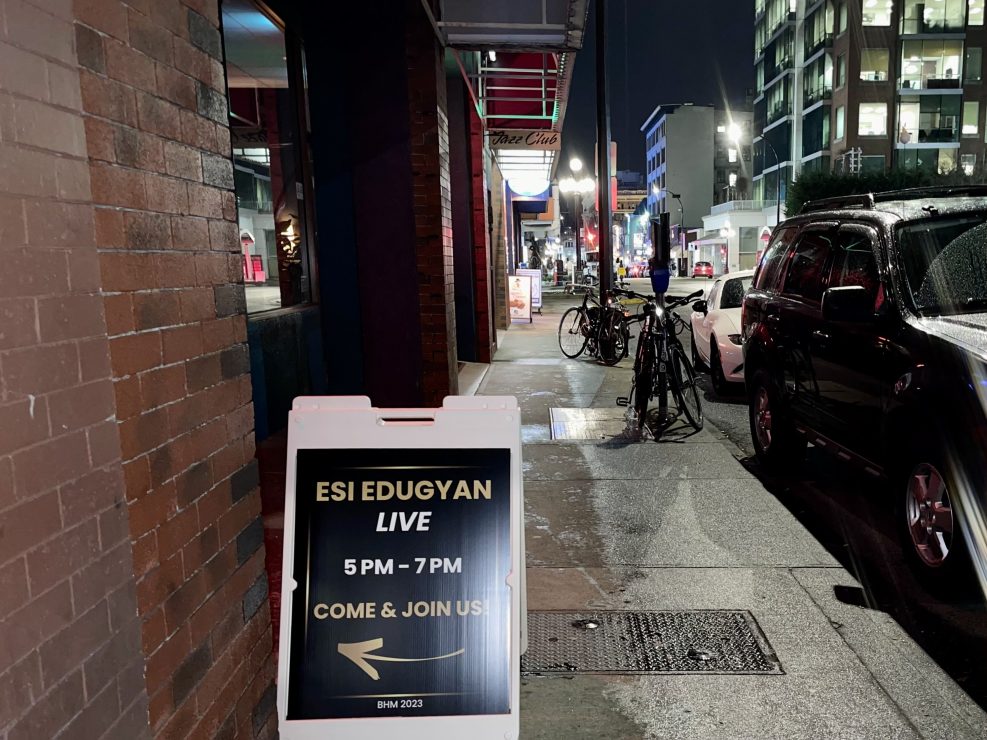The renowned author on Black history and visual storytelling

Photo by Sydney Lobe.
On Thursday, Feb. 16, I trudged up the carpeted stairs at Hermann’s Jazz Club in downtown Victoria. I was visiting the venue with a friend to attend the BC Black History Awareness Society’s event titled Out of the Sun: On Black History and Storytelling. The room upstairs felt warm, bathed in shades of orange light. The effect was a cozy, intimate ambiance that reflected the nature of the evening: a conversation with New York Times Bestselling author Esi Edugyan.
A band called Locrian Tones, made up of artists of African and Caribbean descent, opened the evening with a neo- and Afro-soul set. At one point, the group’s frontman urged the audience to dance along with the performers. Across the venue, I saw a middle-aged couple stand and, arm in arm, start to sway along.
After the band finished, Edugyan was invited to the stage to discuss her newest book of essays titled Out of the Sun: On Race and Storytelling. The book recontextualizes the representations of Black figures from the Renaissance and 18th and 19th centuries in visual art.
What the author offered to us that evening was a searingly insightful ode to the importance of visual mediums in Black storytelling and history.
“I love visual art. I studied visual art at UVic for a time. I thought I might be a visual artist until I realized I really had no talent,” Edugyan said.
“We’re such a visualized culture,” Edugyan explained in reference to the importance of revisiting visual art throughout history.
I found a published statement from a Teen Advisory Group member on the Metropolitan Museum of Art’s website after Edugyan’s talk. The member, identified only as Kristen, writes, “Art from the past holds clues to life in the past.” Kristen explains that by looking at historical portraiture, “we can learn what was important to these people and how they wanted to be remembered.”
The catch, according to Edugyan, is that images of Black figures from the Renaissance period were not “images of living, breathing figures, where you looked at them and your mind immediately went to a place where you were imagining entire lives for them.” Instead, “These were very much images in which most of the figures of colour were defined by slavery or having been slaves.”
In a 2021 New York Times review of the essay collection, Antwaun Sargent writes that the book considers “what it means to be seen, and who remains unseen, in our current identity-conscious, visibility-obsessed culture.”
This sentiment underlines the content of Edugyan’s talk. In a culture that is, and has always been, preoccupied with visibility (and is only becoming increasingly visually inclined), the existence of Black figures throughout history in visual mediums is undeniably political. What were the conditions of those figures’ existences in art? Who was being represented, and by whom, and why? These are the questions that drove Edugyan to investigate and ultimately recontextualize certain stories from art history.
Edugyan explained that in the recontextualization of Black history, there is a reaction of resistance. “There’s a sense when you recontextualize something or rename it that you’re trying to rob it of its history,” she said. In reality, Edugyan explains with resonant clarity, “You’re not diminishing history, you’re in fact enlarging it.”
As the audience question period of the evening commenced, Edugyan let her microphone rest in her lap while she listened to folks speak. Those who asked questions stood before Edugyan with open postures and vulnerable stories. It was clear by the audience’s response that what Edugyan had shared resonated with many.
Edugyan’s prolific understanding of the stakes for recontextualizing historical imagery shines through her book and her conversations surrounding it, and her effort has created an obvious ripple. The impression from the evening that resonated most with me, though, was the sense that according to Edugyan, despite her many accolades and the ample praise of her essay collection, the work she is doing is not noble, it’s necessary.








